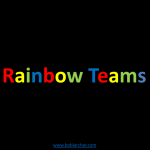Rainbow Teams

Teams, like individuals, have their characteristics.
Some teams are action oriented with their sights firmly on their deliverables; full of focussed energy and committed and accountable for what they are engaged in.
On the downside they can be so task oriented that they forget about the people-side of things
Some teams have a very participative feel to them; they seem very “fluid”, enthusiastic and engaged in dialogue to find creative and novel solutions to problems.
They can also become “lost in creativity” and lose sight of the end-game.
Other teams maintain a positive climate and have the ability to keep cohesion under pressure with a genuine sense of caring and support.
This type of team can sometimes “sweep conflict under the carpet” in order to maintain harmony
Other teams are the “well-oiled machine”; effective processes, procedures & common ways of working with KPI’s, road-maps and clear roles for each member.
Their “dark-side” can manifest itself through inflexibility and the dogmatic application of “the rules”
And, yes, there are teams that manage to combine all of the above.
In the Insights model there are four dominant colours or energies; Fiery Red, Sunshine Yellow, Earth Green and Cool Blue. I’ll leave you to match the colours to my descriptions above.
Although there are dominant colours, no team is monochrome they are all multi-coloured; they are all “rainbows” – but they are all rainbows of different shades. Some are a mix of Fiery Red and Cool Blue, some are a mix of Sunshine Yellow and Earth Green, etc. All the combinations are possible and each team has its own unique combination.
Each team has its own unique “natural” combination of energies and it’s this combination that has invariably allowed (or maybe hindered) the team to be successful. The question to ask is, “will this combination allow the team to become a “high performing team”, or do they need to develop & deploy some of their less used energies?”
The truly rainbow team will be able to maintain focus through results orientation and shared purpose, flow through agility and collaboration, climate through trust and cohesion and processes through working methods and measurements.
The issue is often, how to achieve integration and not disintegration
If a team wants to fully incarnate its teamwork capacity, it will need to integrate the different colours in order to become a real rainbow, not just a rainbow shaded red or blue, etc.
The opposite is disintegration, with colour “cliques” working independently to get things done “their way”